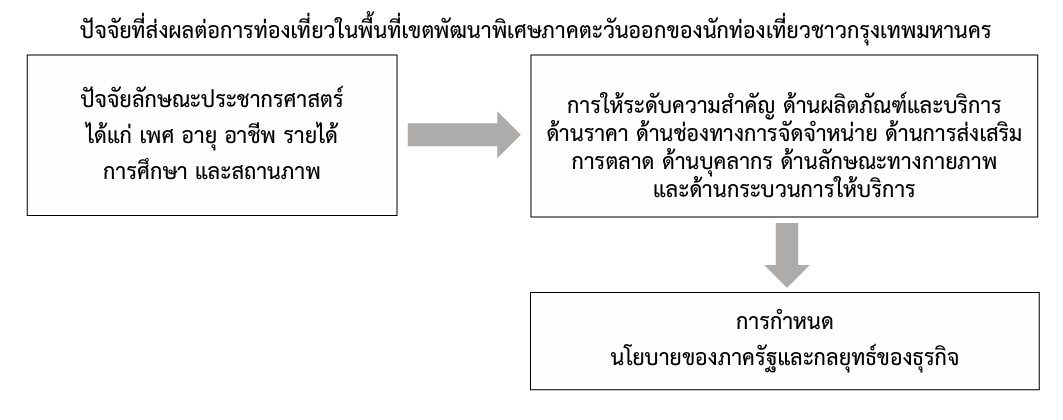Factors affecting tourism in the Eastern Economic Corridor (EEC) of Bangkok tourists
Main Article Content
Abstract
This article aimed to study of (1) the general demographic characteristics and travel behavior of Bangkok tourists traveling to the Eastern Economic Corridor (EEC), (2) the importance level of Marketing Mix Factors of Bangkok tourists traveling to the Eastern Economic Corridor (EEC), and (3) the relationship between demographic factors and marketing mix factors of Bangkok tourists traveling to the Eastern Economic Corridor (EEC). This study is a quantitative analysis. The data collection instrument used in this study was a structured questionnaire. The statistical methods employed for data analysis included descriptive statistics such as percentage, mean, standard deviation, and Likert scale rating. Inferential statistics were also utilized, including t-test, F-test, and Fisher’s Least Significant Difference (LSD) method for pairwise mean comparison. The result of this study found that most respondents traveled primarily to Chonburi Province within the Eastern Economic Corridor, with beaches being the most favored attractions. Preferred accommodations were hotels or resorts rated no higher than four stars. Most of respondents chose to travel on weekends (Saturday–Sunday), typically staying for 1–2 nights, with a travel frequency of 2–3 times per year and an average expenditure per trip ranging from 5,001 to 8,000 Baht. Most expressed an intention to revisit the Eastern Economic Corridor. In addition, respondents placed the highest level of importance on the marketing mix factors of product, price, place (distribution channels), physical evidence, and process. The study also revealed that demographic characteristics significantly influenced the perceived importance of these market mix elements, with occupation and marital status showing the most statistically significant differences at the 95% confidence level. The public sector should consider developing facilities that cater to the needs of working people by providing charging stations for electronic devices in tourist areas, such as high-speed Wi-Fi and dedicated workspaces for those who need to work while traveling. Additionally, a “Tourist Assistance Center” should be established with female staff on duty to increase the sense of safety and comfort for solo travelers, particularly women and divorced individuals. The private sector should invest in small-scale accommodation with a standard not exceeding 4 stars, offering easy access and services tailored to solo travelers. This includes 24-hour shuttle services to enhance safety for solo travelers, especially women. Female-only dormitories, security cameras, adequate lighting, and female staff should be provided to ensure a secure and welcoming environment.
Article Details

This work is licensed under a Creative Commons Attribution-NonCommercial-NoDerivatives 4.0 International License.
References
กชกร จุลศิลป์. (2561). กลยุทธ์การจัดการการตลาดเพื่อส่งเสริมการท่องเที่ยวเชิงอาหารของนักท่องเที่ยวชาวไทยในจังหวัดพระนครศรีอยุธยา. (ศิลปศาสตรมหาบัณฑิต, สถาบันบัณฑิตบริหารศาสตร์).
กระทรวงการท่องเที่ยวและกีฬา. (2567). สถิติด้านการท่องเที่ยว. สืบค้นจาก https://www.mots.go.th/news/category/758.
จุฬาลงกรณ์มหาวิทยาลัย และ สำนักงานคณะกรรมการดิจิทัลเพื่อเศรษฐกิจและสังคมแห่งชาติ. (2565). การเดินทางท่องเที่ยวจากการเคลื่อนที่โทรศัพท์. สืบค้นจาก https://dtac.co.th/mobility-data/dashboard/?srsltid=AfmBOoqSmvxzQSzNOBNFp3NRClb33AR0CNSjSifHN0STGURM-y8c-Kn0.
ชนินทร์ เก่งกล้า และ ธิติมีปลื้ม. (2555). พฤติกรรมของนักท่องเที่ยวชาวไทยที่มีต่อสถานที่ท่องเที่ยวในเขตจังหวัดเพรชบุรี. (บริหารธุรกิจบัณฑิต, มหาวิทยาลัยศิลปากร).
พิชาวีร์ ศักดิ์ทวีพิชากุล. (2554). การตัดสินใจต่อการท่องเที่ยวในประเทศไทยของประชาชนในกรุงเทพมหานคร. (บริหารธุรกิจมหาบัณฑิต, มหาวิทยาลัยรามคำแหง).
สำนักงานสภาพัฒนาการเศรษฐกิจและสังคมแห่งชาติ. (2567). ผลิตภัณฑ์มวรวมรายจังหวัด. สืบค้นจาก https://www.nesdc.go.th/main.php?filename=gross_regional.
Cochran, W. G. (1977). Sampling Techniques. (3rd ed). New York: John Wiley & Sons.

